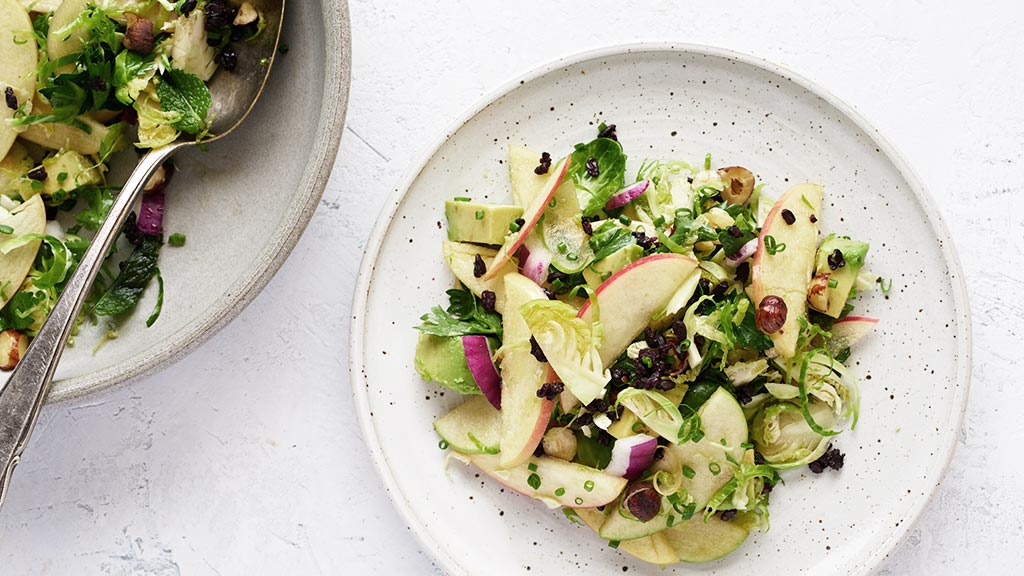Nourish
SIMPLE STEPS TO MAKING BETTER SALADS
As far as we’re concerned, every season is salad season—but spring is a particularly delightful time of year to fill your plate with fresh produce. To help ensure that your bowls of greens and veggies are as helpful (and delicious) to your body as possible, we turned to Jen Curtis, naturopathic physician and barre3 nutrition consultant. Here, she shares is here her best tips to make a much better salad, plus a time-saving tip for washing greens.
BALANCE THE INGREDIENTS
The barre3 portion prescription calls for a balance of protein, fiber, and healthy fats in every meal and snack—and that includes salads! Jen recommends protein from nuts, seeds, avocado, legumes, quinoa, fish, hormone- and antibiotic-free meats; fiber from fresh greens, nuts, seeds; and healthy fats including olive oil, sesame oil, coconut butter, avocado, and/or nuts, and seeds (in addition to adding flavor, these fats will help your body absorb fat-soluble vitamins including Vitamin A, E, and K). This mix will help you stay full until the next meal and will provide balanced energy.
INCLUDE A VARIETY OF INGREDIENTS
The most memorable salads have an appealing mixture of textures. Jen recommends including crunchiness from veggies, nuts, or seeds; creaminess from avocado, healthy oils, or goat cheese; and both cooked and uncooked foods for the best eating experience.
MAXIMIZE NUTRITION
“Apply a bitter such as vinegar, lemon juice, or lime juice, to draw the nutrients out of your veggies” Jen says. Try this simple lemon dressing on your next salad.
CHANGE THINGS UP
It’s easy to grab your go-to ingredients from the produce aisle, but that can send you into a salad rut—not to mention limit the range of nutrients you’re putting in your body. Jen recommends varying the foods you use in your salads to provide well-rounded nutrition. An easy way to do this is to try to eat the rainbow over the course of a week.
And here’s Jen’s tip to help keep those greens fresh in the fridge all week long: Wash and spin greens in a salad spinner. Then, store them in the fridge in an airtight container lined with paper towels or a thin kitchen towel to help absorb moisture. Dress the salad right before you’re ready to eat it (unless it’s made with a hearty base of cabbage or kale), and consider making the dressing ahead of time and storing it separately in an airtight container. Now your salad is ready to throw together the moment you walk in the door!
Looking for some main-dish-worthy salads? We have tons of delicious options in the B3 Kitchen! (Everyone in the office has been raving about this one lately.)
As far as we’re concerned, every season is salad season—but spring is a particularly delightful time of year to fill your plate with fresh produce. To help ensure that your bowls of greens and veggies are as helpful (and delicious) to your body as possible, we turned to Jen Curtis, naturopathic physician and barre3 nutrition consultant. Here, she shares is here her best tips to make a much better salad, plus a time-saving tip for washing greens.
BALANCE THE INGREDIENTS
The barre3 portion prescription calls for a balance of protein, fiber, and healthy fats in every meal and snack—and that includes salads! Jen recommends protein from nuts, seeds, avocado, legumes, quinoa, fish, hormone- and antibiotic-free meats; fiber from fresh greens, nuts, seeds; and healthy fats including olive oil, sesame oil, coconut butter, avocado, and/or nuts, and seeds (in addition to adding flavor, these fats will help your body absorb fat-soluble vitamins including Vitamin A, E, and K). This mix will help you stay full until the next meal and will provide balanced energy.
INCLUDE A VARIETY OF INGREDIENTS
The most memorable salads have an appealing mixture of textures. Jen recommends including crunchiness from veggies, nuts, or seeds; creaminess from avocado, healthy oils, or goat cheese; and both cooked and uncooked foods for the best eating experience.
MAXIMIZE NUTRITION
“Apply a bitter such as vinegar, lemon juice, or lime juice, to draw the nutrients out of your veggies” Jen says. Try this simple lemon dressing on your next salad.
CHANGE THINGS UP
It’s easy to grab your go-to ingredients from the produce aisle, but that can send you into a salad rut—not to mention limit the range of nutrients you’re putting in your body. Jen recommends varying the foods you use in your salads to provide well-rounded nutrition. An easy way to do this is to try to eat the rainbow over the course of a week.
And here’s Jen’s tip to help keep those greens fresh in the fridge all week long: Wash and spin greens in a salad spinner. Then, store them in the fridge in an airtight container lined with paper towels or a thin kitchen towel to help absorb moisture. Dress the salad right before you’re ready to eat it (unless it’s made with a hearty base of cabbage or kale), and consider making the dressing ahead of time and storing it separately in an airtight container. Now your salad is ready to throw together the moment you walk in the door!
Looking for some main-dish-worthy salads? We have tons of delicious options in the B3 Kitchen! (Everyone in the office has been raving about this one lately.)










2 people have left a comment. Join the conversation!
View Comments